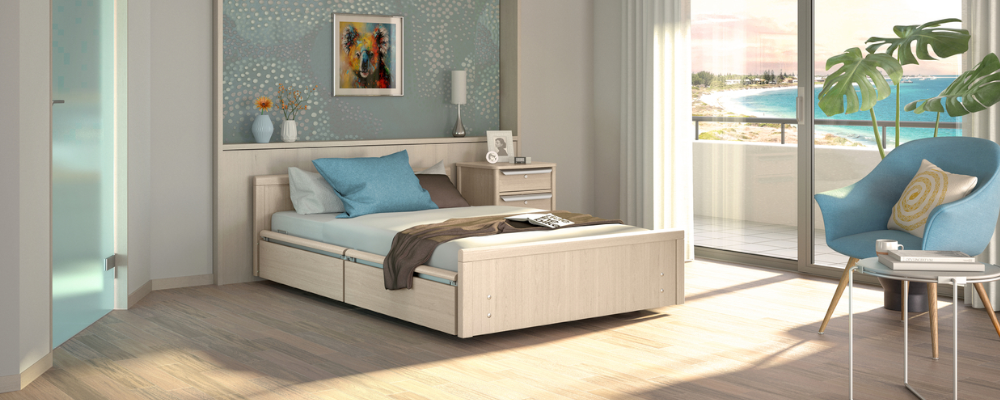The low care bed with split side guards and an integrated bed extension is now standard. ‘The decision in care homes revolves around these three key features,’ says Ringo Wittig. He has been in the business for almost 30 years – ten of them with wissner-bosserhoff. The 51-year-old is a care bed expert and advises a number of providers between Weser-Ems and the Rhineland on what makes a perfect care bed.
Fixation-free design

As a regional sales manager, Ringo Wittig categorises the requirements into several aspects. First of all, it is about keeping residents mobile. This is achieved by means of variable height adjustment as well as side and head-end stand-up aids. Secondly, users are increasingly looking for a non-restrictive design, such as side guards, that still allows the attachment of full protection, such as side guards, if necessary. Ideally, the perfect care bed enables these protective devices to be removed. ‘This prevents the side guards from being automatically raised over the entire length of the bed as a matter of routine,’ explains the expert.
Height adjustment for more safety
Another aspect of bed design is height adjustment. Low nursing care beds, which can be lowered to a lying height of 15 cm without a mattress, can be found on the market today. Wittig points out, however, that the dignity of people to participate in mobility is hereby suppressed to the maximum. Because if, when sitting at the edge of the bed, the knees are above the pelvis, it is almost impossible for seniors to get up. He advices that ‘carers should keep safety in mind’ and adjust the bed to a position allowing residents to get out safely. A rule of thumb is: day position: 41 cm, night position: 30 cm. Additionally, central brake locks, where all four castors can be released at the same time, make it easier to move the bed, according to the expert. All adjustment mechanisms should be intuitive and easy to operate.
Perfect care bed with digital connection
If you want a future-proof care bed, you should make sure that digital reporting systems are integrated or can be easily retrofitted. This enables care staff to monitor the condition of residents who require a great deal of care. Wittig provides the reason for the smart bed: a lack of skilled workers. For example, sensors that are sensitive to moisture can be used to check for incontinence at night, a task that previously had to be done by hand and which is also beneficial for the patient. ‘Who wants to be woken up at two o’clock in the morning?’ Wittig gets to the heart of the matter. The digital reporting system should also be integrated into the bed control system to avoid annoying and disruptive cables in the bed environment. It is also important to think about updates in general. Manufacturers should guarantee that their smart beds can meet the requirements of the telematics infrastructure today and at any time.
Ergonomic lying position
When it comes to the lying position, three aspects are crucial for a perfect care bed. An extended backrest, for example, supports an ergonomic lying position. ‘The seat area should also be wide enough,’ says expert Wittig. This minimises shear forces and thus reduces the risk of pressure ulcers. Finally, the seat should be able to be opened by means of a double retraction at the head and thigh sections. This provides up to 17 cm more space for the pelvis, making the sitting positions more comfortable. At the same time, the pressure on the buttocks is reduced, which also lowers the risk of pressure ulcers.
Different interests for the perfect care bed
When purchasing care beds, several interests play a role. Residents are the top priority: they want to be able to lie comfortably and move safely in and out of bed. It should also be possible to adapt the bed to individual needs. From the point of view of the nursing staff, a perfect care bed should support efficient workflows through easily accessible controls and digital systems. In-house technicians look to see whether simple maintenance and repairs are possible. Modular construction and clear documentation are helpful in this regard. Experience shows that the owners and operators of nursing homes prioritise cost efficiency and durability. This in turn means that care beds should be made of high-quality materials and be capable of adapting smart technologies.


